Madame du Barry
| Jeanne Bécu, comtesse du Barry | |
|---|---|
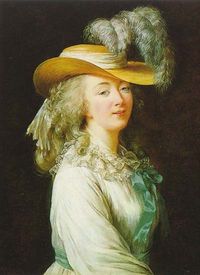 Madame du Barry by Élisabeth Vigée Le Brun, 1781 |
|
| Born | 19 August 1743 Vaucouleurs, France |
| Died | 8 December 1793 (aged 50) Paris, France |
| Occupation | Maîtresse-en-titre to Louis XV |
| Spouse | Comte Guillaume du Barry |
| Parents | Anne Bécu and possibly Jean Baptiste Gormand de Vaubernier |
Jeanne Bécu, comtesse du Barry (19 August 1743 – 8 December 1793) was the last Maîtresse-en-titre of Louis XV of France and one of the victims of the Reign of Terror during the French Revolution.[1][2]
Contents |
Early life
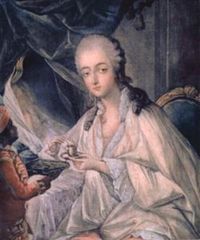
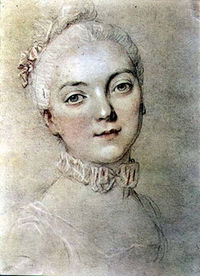
Jeanne Bécu was born at Vaucouleurs, in the Meuse department in Lorraine, France, the illegitimate daughter of Anne Bécu, a woman of enticing beauty[3], whose occupation was as a seamstress. Jeanne's father was possibly Jean Baptiste Gormand de Vaubernier, a friar known as 'Brother Angel.' During her childhood, one of her mother's lovers, Monsieur Billard-Dumonceaux, father of Jeanne's brother Claude (who died in infancy when only ten months old) took both Anne & three-year-old Jeanne into his household when they travelled from Vaucouleurs to Paris and installed Anne as a cook. Little Jeanette was well-liked by Dumonceaux's Italian mistress Francesca (known in French as Madame, or La Frédérique), who pampered her in all luxury. In time Dumonceaux took decision, and funded Jeanette's education at the convent of Saint-Aure[4].
At the age of fifteen, Jeanne left the convent for coming of age, and was first given the job as an assistant to a young hairdresser named Lametz (a brief relationship with whom may have produced a daughter, although it is very improbable[5]), then as a companion (dame de compagnie) to an elderly widow, Madame de la Garde, and later as a milliner's assistant (better known as a grisette) in a haberdashery shop named 'À la Toilette', owned by a certain Monsieur Labille, with the daughter of whom, the future famed painter Adélaïde Labille-Guiard, she became very good friends. As reflected in art from the time, Jeanne was a remarkably attractive blonde woman. Her beauty came to the attention of Jean-Baptiste du Barry, a high-class pimp/procurer [6] (nicknamed le roué) and owner of a casino, in 1763 whilst Jeanne was entertaining in Madame Quisnoy's brothel-casino [7]. She introduced herself as Jeanne Vaubernier. He installed her in his household and made her his mistress and, under the appellation of Mademoiselle Lange, helped establish her career as a courtesan in the highest circles of Parisian society, enabling her to take several aristocratic men as brief lovers, or clients[8].
Life as a courtesan and official mistress to Louis XV
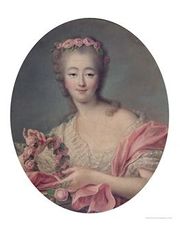
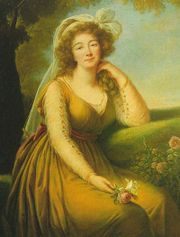
As Mademoiselle Lange, she immediately became a sensation in Paris, building up a large aristocratic clientele. The dashing Maréchal de Richelieu became one of her recurring customers. Because of this, Jean du Barry saw her as a means of influence with Louis XV, who became aware of her in 1768 while she was on an errand at Versailles which involved the duc de Choiseul, who found her rather ordinary, in contrast to what most other men thought of her. In any case, Jeanne could not qualify as an official royal mistress unless she had a title; this was solved by her marriage to du Barry's brother, comte Guillaume du Barry, on 1 September 1768, including also a false birth certificate created by Jean, making Jeanne younger by three years and of nobler descent[9].
For now, Jeanne was installed below the King's quarters in Lebel's former rooms. She lived a lonely life, not able to be seen with the King since no formal presentation had taken place. Her official sponsor, Madame de Béarn, presented her to the Court at Versailles on 22 April 1769. Jeanne was wearing a queenly silvery white gown brocaded with gold, bedecked in jewels sent by the king the night before, and with huge panniers at the sides, a dress which had been ordered especially by Richelieu, and the likes of which many courtiers had claimed had never been seen before.
Jeanne was a tremendous triumph. She now wore extravagant gowns of great proportions both in creation and cost, exhausting the treasury all the more[10]. With diamonds covering her delicate neck and ears, she was now the king's maîtresse déclarée. Due to her new position at Court, she made both friends and enemies. Her most bitter rival was the Comtesse Béatrix de Grammont, Choiseul's sister, who futilely had tried her best to acquire the place of the late Marquise de Pompadour. Jeanne's first friend was Claire Françoise, better known as 'Chon', brought from Languedoc by her brother Jean du Barry to accompany her then-friendless sister in-law.
Jeanne quickly accustomed herself to living in luxury (which she was already introduced to when living with Dumonceaux), but her good nature was not spoilt. When the old Comte and Comtesse de Lousene were forcibly evicted from their château due to heavy debts, they were sentenced to beheading because the Comtesse had shot dead a bailiff and a police officer while resisting[11]. To their great fortune, they were good friends with Madame de Béarn, who told Jeanne of their situation. Though warned by Richelieu of her possible failure, she asked the king to pardon them, refusing to rise from her kneeling posture if he did not accept her request. Louis XV was astounded and his heart thawed, saying, "Madame, I am delighted that the first favour you should ask of me should be an act of mercy!".[12]
While Jeanne was part of the faction that brought down the Duc de Choiseul, Minister of Foreign Affairs, she was unlike her late predecessor, Madame de Pompadour, in that she had little interest in politics, rather preferring to pass her time having new gowns made and ordering jewelry.
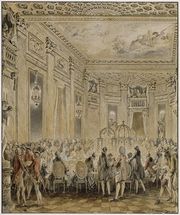
While Jeanne was known for her good nature and support of artists, she grew increasingly unpopular because of the king's financial extravagance towards her. Her relationship with Marie Antoinette, who was married to the Dauphin of France, was contentious. Marie Antoinette supported Choiseul as the proponent of the alliance with Austria and also defied court protocol by refusing to speak to Mme du Barry, owing not only to her disapproval of the latter's background, but also after hearing from the Comte de Provence of du Barry's amused reaction to a story told by the Prince de Rohan during one of her dinner parties, in which Marie Antoinette's mother, Maria Theresa, was slandered[13]. What was to many an amusing incident had now become a phenomenon at Versailles, and since Marie Antoinette refused to speak to her, Madame du Barry furiously complained to the king. Eventually, during a ball on New Year's Day 1772, Marie Antoinette spoke to her, saying, "There are many people at Versailles today," but she made it clear to Count Mercy the very next instant that she would say nothing else to du Barry.
In time, the king started to show his age by constantly thinking of death and repentance, even missing 'appointments' in Jeanne's boudoir[14]. During a stay at the Petit Trianon with her, Louis XV felt the first symptoms of smallpox. He was brought back to the palace at night and put to bed, where his three daughters and Madame du Barry stayed with him. On 4 May 1774, the king suggested to Madame du Barry that she leave Versailles, both to protect her from infection and to prepare for confession and receiving last rites.[15] She immediately retired to her estate near Rueil. Following the death of Louis XV, she was quickly exiled to the Abbaye du Pont-aux-Dames near Meaux-en-Brie.[16]
Life after Louis XV
Two years later, she moved to the Château de Louveciennes. In the following years, she had a liaison with Louis Hercule Timolon de Cossé, Duke of Brissac.[17] She later also fell in love with Henry Seymour (of Redland),[18] whom she met when he moved with his family to the neighborhood of the Château. In time, Seymour became fed up with his secret love affair and sent a painting to Jeanne with the words 'leave me alone' written in English at the bottom, which the painter Lemoyne copied in 1796. The duc de Brissac proved the more faithful, having kept Jeanne in his heart even though he jealously knew of her affair with Seymour. Unfortunately, the Revolution brought misfortune for the two. Brissac had been captured while visiting Paris, and was slaughtered by a mob. Late one night, Jeanne heard the sound of a small drunken crowd approaching the Château, and into the opened window where she looked out someone threw a blood-stained cloth. To Jeanne's horror, it contained Brissac's head, at which sight she fainted.
Imprisonment, trial and execution
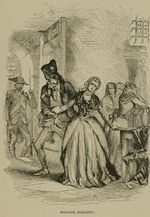
In 1792, Madame du Barry made several trips to London in order to authenticate jewelry, which had been stolen from her with the aid of her now-grown Bengali page Zamor, who disliked his mistress for her airy attitude.[19] In addition, she was suspected of financially assisting émigrés who had fled the French Revolution. The following year she was arrested. The Revolutionary Tribunal of Paris accused her of treason and condemned her to death. On 8 December 1793, Madame du Barry was beheaded by guillotine on the Place de la Révolution (nowadays, Place de la Concorde). Her corpse was disposed of in the Madeleine Cemetery. She had tried to save herself by revealing the hiding places of the gems she had hidden around her property.[20]
On the way to the guillotine, she continually collapsed in the tumbrel and cried "You are going to hurt me! Why?!" Terrified, she screamed for mercy and accused the crowd. Her last words to the executioner were: "One moment more, Mr. Executioner, I beg you!" She was buried in a common grave in the Madeleine cemetery, where many victims of the Terror – including Louis XVI and Marie-Antoinette had also been buried.[21]
The proceeds went to the Tribunal de Paris. Later, the jewels she had smuggled out of France to England were sold by auction at Christie's in 1795 for £8,791.
The necklace involving Jeanne de la Motte-Valois, and which Queen Marie Antoinette was wrongly accused of bribing the Cardinal de Rohan to purchase for her, was originally destined for Madame du Barry by Louis XV, who died before the purchase could take place, leaving the jewellers Bohmer and Bassenge desperate for a buyer of the over-expensive creation.
In popular culture
- Her famous last words ("Encore un moment!") serve as a symbol of existential angst when they are raised as a topic of conversation on at least two separate occasions in Fyodor Dostoevsky's 1869 novel, The Idiot.
- She inspired a wax figure at Madame Tussaud's in London, called The Sleeping Beauty, which is the oldest existing figure on display.
- A short two-page comic strip La Rue perdue ("The lost street") was published in 1978, featuring Gil Jourdan, a detective series created by Maurice Tillieux. Set in 1953 it has Jourdan trying to find out why a fake guillotine blade is hanging outside the door of a black African friend. The one responsible turns out to be a man obsessed with du Barry and taking his anger at her death out on Jourdan's friend who looks like Zamor, the man whose actions led to her execution. The action is set in Rue Maître Albert (Maître Albert Street).
In music
- The comtesse du Barry is the subject of an operetta entitled Gräfin Dubarry (1879) by Karl Millöcker.
- She was also the subject of a musical by Cole Porter titled DuBarry Was a Lady, featuring Ethel Merman in two roles, a nightclub singer named May Daley, and Madame Dubarry. Bert Lahr co-starred as a washroom attendant in the nightclub who dreams he is Louis XV. The 1943 movie version starred Lucille Ball in the title role, with co-stars Red Skelton and Gene Kelly.
- She is mentioned in the introduction to Lydia the Tattooed Lady, made famous by Groucho Marx.
In film
She was portrayed by:
- Theda Bara in the 1917 film Madame Du Barry directed by J. Gordon Edwards
- Pola Negri in the 1919 film Madame Du Barry directed by Ernst Lubitsch
- Norma Talmadge in the 1930 film Du Barry, Woman of Passion
- Dolores del Río in the 1934 film Madame Du Barry, directed by William Dieterle
- Gladys George in the 1938 MGM film, Marie Antoinette, which starred Norma Shearer in the title role
- Lucille Ball in the 1943 movie version of DuBarry Was a Lady
- Margot Grahame in the 1949 film Black Magic as Mme du Barry. It also starred Orson Welles in the lead role of Count Cagliostro
- Martine Carol in the 1954 film Madame du Barry directed by Christian-Jaque
- Italian actress Asia Argento in Sofia Coppola's 2006 film Marie Antoinette
- Madame du Barry also appears in the famous anime and manga series The Rose of Versailles as a villainous, scheming enemy of Marie Antoinette; her struggles with the young princess are a major concern of the story in its early stages.
References and notes
- ↑ A King's favourite, Madame du Barry, and her times from hitherto unpublished documents by Claude Saint-André with an introduction by Pierre de Nolhac and 17 illustrations, New York, Mc Bride, Nast & Company, 1915, p. 3 (a translation from the French publication by Tallandier, Paris, 1909.)
- ↑ Michel Antoine, Louis XV, Librairie Arthème Fayard, Paris, 1989, p. 887.
- ↑ Haslip, Joan, Madame du Barry: The Wages of Beauty, Grove Weidenfeld, New York, 1992.
- ↑ Haslip, p. 3.
- ↑ Haslip, p. 6.
- ↑ Haslip, p. 13.
- ↑ Stoeckl, Agnes de, Mistress of Versailles: the Life of Madame du Barry, John Murray, London, 1966, p. 23.
- ↑ Haslip, p. 16: such reference is made in the sentence that Jeanne was a talented courtesan, whom sometimes '(Jean) du Barry regretted when necessity forced him to merchandise what he would willingly have kept for himself', obviously indicating Jeanne who was well aware her beauty and sexual charms were a very good source to climb the ladder of success. She is referred to many times in many books as a courtesan, who in common language is a high-class prostitute, or a prostitute (though by no means should one think that she was a common soliciting street walker)
- ↑ Haslip, p. 27.
- ↑ Haslip, p. 32: 'The carriages, jewels....reclaim the money from the royal treasury.
- ↑ de Stoeckl, p. 43.
- ↑ Loomis, Stanley, Du Barry: A Biography, Lippincott, Philadelphia, 1959, re-ed. 1965, pp. 55–56.
- ↑ Haslip, p. 78: "Prince de Rohan had made fun of the pious old Empress... No one, it appears, had laughed so heartily as the hostess"
- ↑ Haslip, p. 81: "She never dared go out for long,...rest for a while in peace"
- ↑ http://www.newadvent.org/cathen/05716a.htm
- ↑ Bernier, pp. 246–249.
- ↑ Haslip, p. 133.
- ↑ Haslip, p. 121
- ↑ Haslip, p. 151.
- ↑ Stoeckl, p. 174.
- ↑ Madame Du Barry on www.findagrave.com
Sources
- Antoine, Michel, Louis XV, Librairie Arthème Fayard. Paris. 1989 (French).
- Bernier, Oliver, Louis The Beloved, The Life of Louis XV, Doubleday & Company, Inc.: Garden City, New York. 1984. ISBN 0-385-18402-6
- Castelot, André, Madame du Barry, Perrin, Paris, 1989.
- Haslip, Joan, Madame du Barry: the Wages of Beauty, Grove Weidenfeld, New York, 1992, ISBN 13: 9780802112569, ISBN 10: 0802112560.
- La Croix de Castries, René de, Madame du Barry, Hachette, Paris, 1967.
- Loomis, Stanley, Du Barry : A Biography, Lippincott, Philadelphia, 1959.
- Saint-André, Claude, A King's favourite, Madame du Barry, and her times from hitherto unpublished documents, with an introduction by Pierre de Nolhac, New York, Mc Bride, Nast & Company, 1915; translated from the French Madame du Barry, published by Tallandier, Paris, 1909.
- Saint Victor, Jacques de, Madame du Barry, un nom de scandale, Perrin, Paris, 2002.
- Stoeckl, Agnes, (Baroness de), Mistress of Versailles: the Life of Madame du Barry, John Murray, London, 1966.
- Vatel, Charles, Histoire de madame du Barry, L. Bernard, Paris, 1883.
External links
- Full text of Memoirs of the Comtesse Du Barry from Project Gutenberg
- The French Revolution — Madame Du Barry and Princess de Lamballe
|
|||||||||||||||||||||||||||||||||||||||||||||||||||||||||||||||||||||||||||||||||||||||||||||||||||||||||||||||||||||||||||||||||||||||||||||||||||